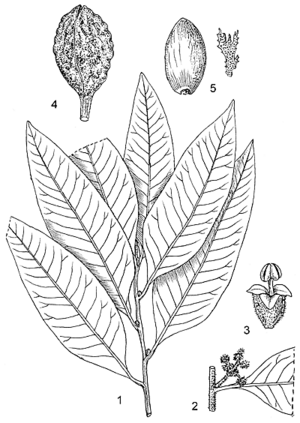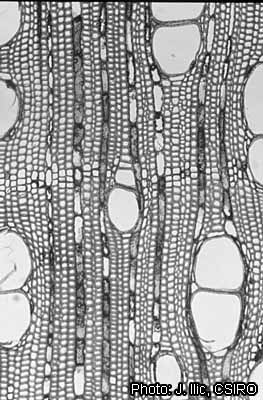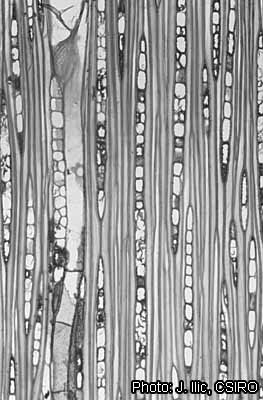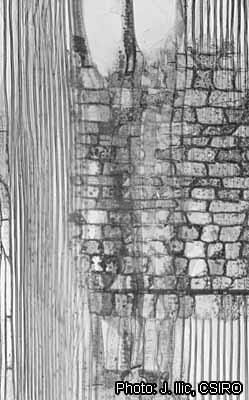Cephalosphaera usambarensis (PROTA)
Introduction |
| General importance | |
| Geographic coverage Africa | |
| Geographic coverage World | |
| Dye / tannin | |
| Medicinal | |
| Timber | |
| Auxiliary plant | |
| Climate change | |
| Conservation status | |
Cephalosphaera usambarensis (Warb.) Warb.
- Protologue: Bot. Jahrb. Syst. 33: 383 (1904).
- Family: Myristicaceae
Vernacular names
- Mtambao, mtambara (Sw).
Origin and geographic distribution
Cephalosphaera usambarensis is restricted to eastern Kenya and Tanzania.
Uses
The wood is most commonly used for veneer and plywood, but is also suitable for light construction, light flooring, joinery, interior trim, furniture, toys, novelties, agricultural implements, boxes, crates, carving, turnery, matches, hardboard, particle board and pulpwood.
The bark yields a brown dye that has been used for dyeing cloth. The tree, with its crown providing comparatively light shade, is planted in agroforestry systems and along river banks to reduce erosion. The roots are used in local medicine in Tanzania to treat hernia.
Production and international trade
In 1960 Cephalosphaera usambarensis was considered one of the most useful multi-purpose timber trees of Tanzania. At the beginning of the 1970s it was a major source of plywood. In 1985 it was ranked eighth on the list of most important timbers (in volume) of the East Usambara Mountains in Tanzania, and tenth in 2001. In 1990 the price of a plank was US$ 2.40, in 2001 US$ 2.90. Cephalosphaera usambarensis seems no longer to be harvested for commercial purposes because of declining populations due to over-exploitation.
Properties
The heartwood is pale reddish brown and indistinctly demarcated from the sapwood. The grain is usually straight, texture medium.
The wood is medium-weight, with a density of 510–650 kg/m³ at 12% moisture content. It air dries rather slowly, and shows little degrade during drying even when kiln-dried rapidly. The rates of shrinkage are moderately high, from green to 12% moisture content 3.0% radial and 6.5% tangential. It takes 5–6 weeks to air dry boards of 2.5 cm thick from 65% to 14% moisture content and 4 months to dry boards of 5 cm thick. Once dry, the wood may be unstable in service. At 12% moisture content, the modulus of rupture is 93 N/mm², modulus of elasticity 16,900 N/mm², compression parallel to grain 44 N/mm², shear 12.5 N/mm² and Janka side hardness 2670–3290 N.
The wood saws and works easily with both hand and machine tools, although a reddish gum may cause some problems. The wood planes well, but a 30° cutting angle is recommended. The wood moulds and mortises well, and it finishes smoothly and polishes well. The nailing and gluing properties are good. The wood peels well, but the veneer may split during drying. The turning properties are satisfactory. The wood is not durable, being susceptible to fungal and insect attacks. The wood is moderately resistant to impregnation with preservatives, but can be treated satisfactorily under pressure.
The gum from the bark is about 73% soluble in water and contains tannin. The semi-solid fat in the seed has been recorded to cause dermatitis in susceptible people.
Adulterations and substitutes
The wood of Cephalosphaera usambarensis resembles that of Pycnanthus angolensis (Welw.) Warb., which is used for similar purposes.
Description
- Evergreen, dioecious, medium-sized to large tree up to 50(–60) m tall; bole branchless for up to 25(–30) m, straight and cylindrical, up to 90(–160) cm in diameter, sometimes with small buttresses; bark surface smooth, whitish to pale brown or dark grey, inner bark granular, pale orange-brown with paler markings, exuding copious red gum; crown small, rounded, rather open; young twigs reddish brown short-hairy, soon becoming glabrous.
- Leaves alternate, simple and entire; stipules absent; petiole c. 1 cm long; blade oblong to oblong-lanceolate, 8.5–29 cm × 3–7.5 cm, cuneate at base, acute to short-acuminate at apex, glabrous, pinnately veined with 13–20 pairs of lateral veins.
- Inflorescence an axillary panicle up to 7 cm long, reddish brown hairy, with flowers in many-flowered heads.
- Flowers unisexual, regular, up to 3 mm long, yellowish, sessile, perianth cup-shaped, 3–4(–5)-lobed, reddish brown short-hairy; male flowers with 3–4(–5) fused stamens, filaments merged into a column; female flowers with superior 1-celled ovary.
- Fruit an ellipsoid to oblong-ellipsoid drupe 5.5–6.5 cm × 3–4 cm, yellow-green, dehiscent with 2 spoon-shaped valves, 1-seeded.
- Seed ellipsoid to oblong-ellipsoid, 4–5 cm long, cream-coloured to pale brown, with yellow to pale brown, glandular-dotted, laciniate aril.
- Seedling with hypogeal germination.
Other botanical information
Cephalosphaera comprises a single species. It seems most closely related to the small genus Brochoneura from Madagascar.
Anatomy
Wood-anatomical description (IAWA hardwood codes):
- Growth rings: 2: growth ring boundaries indistinct or absent.
- Vessels: 5: wood diffuse-porous; (12: solitary vessel outline angular); 13: simple perforation plates; 14: scalariform perforation plates; 15: scalariform perforation plates with ≤ 10 bars; 21: intervessel pits opposite; 22: intervessel pits alternate; (23: shape of alternate pits polygonal); 27: intervessel pits large (≥ 10 μm); 31: vessel-ray pits with much reduced borders to apparently simple: pits rounded or angular; 32: vessel-ray pits with much reduced borders to apparently simple: pits horizontal (scalariform, gash-like) to vertical (palisade); 42: mean tangential diameter of vessel lumina 100–200 μm; 46: ≤ 5 vessels per square millimetre; 47: 5–20 vessels per square millimetre.
- Tracheids and fibres: 61: fibres with simple to minutely bordered pits; 63: fibre pits common in both radial and tangential walls; 65: septate fibres present; 66: non-septate fibres present; 68: fibres very thin-walled; 69: fibres thin- to thick-walled.
- Axial parenchyma: 78: axial parenchyma scanty paratracheal; 79: axial parenchyma vasicentric; (92: four (3–4) cells per parenchyma strand); 93: eight (5–8) cells per parenchyma strand; (94: over eight cells per parenchyma strand).
- Rays: 97: ray width 1–3 cells; 106: body ray cells procumbent with one row of upright and/or square marginal cells; 107: body ray cells procumbent with mostly 2–4 rows of upright and/or square marginal cells; (108: body ray cells procumbent with over 4 rows of upright and/or square marginal cells); 115: 4–12 rays per mm.
- Secretory elements and cambial variants: 132: laticifers or tanniferous tubes.
- Mineral inclusions: 152: crystals of other shapes (mostly small); 154: more than one crystal of about the same size per cell or chamber.
Growth and development
Seedlings are shade tolerant and can be found under the mother tree in the forest. However, natural regeneration is often poor. Once established, young trees may grow fairly fast. In a plantation of 54 years old the size of the boles showed considerable variation, with a maximum bole diameter of 68 cm.
Ecology
Cephalosphaera usambarensis occurs in evergreen rainforest at 200–1500 m altitude, often on steep slopes and along rivers.
Propagation and planting
Seeds of Cephalosphaera usambarensis are recalcitrant. They are heavy, with about 35 seeds per kg, and have a thin seed coat and a small embryo embedded in a massive endosperm. After collection, they should be packed in cotton bags in quantities of less than 10 kg. They loose viability quickly and should be sown within 6 weeks after collection. The germination rate of fresh seed without pre-treatment is high, up to 97% 6–7 weeks after sowing. Scarification of the seeds can hasten germination, and when scarified seeds are sown in warm moistened soil litter under shade they germinate within 3 weeks. The seeds cannot withstand desiccation below 25% moisture content, but they can be stored at temperatures below 0°C. Seedling establishment is usually very low when seeds are sown directly into the field because they are often damaged by rodents. It is preferable to sow them into polyethylene bags and plant seedlings out at the start of the rainy season once they have reached a height of 30–50 cm.
Management
Cephalosphaera usambarensis usually occurs scattered and in low densities in the natural forest. It has been planted in plantations. In the East Usambara mountains in Tanzania, Maesopsis eminii Engl. has been planted as a nurse tree in young Cephalosphaera usambarensis plantations.
Harvesting
The bole usually does not split during felling operations and is quite easy to fell with hand tools such as the two-man crosscut saw, bow saw and axe.
Handling after harvest
Freshly harvested logs are susceptible to blue-stain and borer attacks and should be converted immediately or treated with preservatives. Treatment of the timber with an anti-stain solution before stacking for air drying is recommended. However, felling shakes may occur when large trees are harvested, and compression failures can be present in their butt logs.
Genetic resources
Cephalosphaera usambarensis is threatened because of over-exploitation and low regeneration rates. It is endemic to a comparatively small area in eastern Kenya and Tanzania, where it is subjected to serious habitat degradation, and has been included in the IUCN Red List as vulnerable.
Prospects
Cephaloshaera usambarensis is greatly valued as a source of multi-purpose timber, and especially for plywood production. Moreover, it has good prospects for agroforestry systems and for commercial timber plantations. Research on growth rates, propagation and appropriate management systems is needed. Cephalosphaera usambarensis should be included in domestication programmes because sustainable and economically viable timber production from natural forest seems no longer possible within its limited area of distribution.
Major references
- Anonymous, 1960. Cephalosphaera usambarensis (mtambara). Timbers of Tanganyika. Utilisation Section, Forest Division, Moshi, Tanzania. 7 pp.
- Bolza, E. & Keating, W.G., 1972. African timbers: the properties, uses and characteristics of 700 species. Division of Building Research, CSIRO, Melbourne, Australia. 710 pp.
- Chudnoff, M., 1980. Tropical timbers of the world. USDA Forest Service, Agricultural Handbook No 607, Washington D.C., United States. 826 pp.
- Msanga, H.P., 1998. Seed germination of indigenous trees in Tanzania: including notes on seed processing, storage and plant uses. Canadian Forest Service, Edmonton, Canada. 292 pp.
- Mugasha, A.G., 1978. Direct sowing of Beilschmiedia kweo (Mildbr.) Robyns & Wilczek, Cephalosphaera usambarensis Warb. and Newtonia buchananii (Baker) Gilbert & Boutique at Amani and Kwamkoro, Tanzania. Tanzania Silviculture Technical Note 40. 11 pp.
- Mugasha, A.G., 1978. The growth of Cephaloshaera usambarensis at Amani and Kwamkoro, Tanzania. Tanzania Silviculture Technical Note 36. 6 pp.
- Mugasha, A.G., 1983. The silviculture of Tanzanian indigenous tree species. IV. Cephalosphaera usambarensis. Tanzania Silviculture Technical Note 58. 13 pp.
- Roe, D., Mulliken, T, Milledge, S., Mremi, J., Mosha, S. & Grieg-Gran, M., 2002. Making a killing or making a living?: wildlife trade, trade controls and rural livelihoods. Biodiversity and Livelihoods Issues 6. TRAFFIC, Cambridge & IIED, London, United Kingdom. 114 pp.
- Takahashi, A., 1978. Compilation of data on the mechanical properties of foreign woods (part 3) Africa. Shimane University, Matsue, Japan. 248 pp.
- Verdcourt, B., 1997. Myristicaceae. In: Polhill, R.M. (Editor). Flora of Tropical East Africa. A.A. Balkema, Rotterdam, Netherlands. 10 pp.
Other references
- Bryce, J.M., 1966. The strength properties of Tanzania timbers. Technical Note No 35. Tanzania Forest Division, Utilisation Section, Moshi, Tanzania. 17 pp.
- Bryce, J.M., 1967. The commercial timbers of Tanzania. Tanzania Forest Division, Utilisation Section, Moshi, Tanzania. 139 pp.
- Greenway, P.J., 1941. Dyeing and tanning plants in East Africa. Bulletin of the Imperial Institute 39: 222–245.
- Lovett, J. & Clarke, G.P., 1998. Cephalosphaera usambarensis. In: IUCN. Red list of threatened species. Version 2010.4. [Internet] http://www.iucnredlist.org January 2011.
- Lovett, J.C., Ruffo, C.K., Gereau, R.E. & Taplin, J.R.D., 2006. Field guide to the moist forest trees of Tanzania. [Internet] Centre for Ecology Law and Policy, Environment Department, University of York, York, United Kingdom. http://celp.org.uk/ projects/ tzforeco/. January 2011.
- Malde, K., 1972. Design stresses for seasoned Cephalosphaera usambarensis (mtambara). Tanzania Forest Division, Utilisation Section, Moshi, Tanzania. 4 pp.
- Watt, J.M. & Breyer-Brandwijk, M.G., 1962. The medicinal and poisonous plants of southern and eastern Africa. 2nd Edition. E. and S. Livingstone, London, United Kingdom. 1457 pp.
Sources of illustration
- Verdcourt, B., 1997. Myristicaceae. In: Polhill, R.M. (Editor). Flora of Tropical East Africa. A.A. Balkema, Rotterdam, Netherlands. 10 pp.
Author(s)
- W. Mojeremane, Department of Crop Science and Production, Botswana College of Agriculture, Private Bag 0027, Gaborone, Botswana
Correct citation of this article
Mojeremane, W., 2011. Cephalosphaera usambarensis (Warb.) Warb. [Internet] Record from PROTA4U. Lemmens, R.H.M.J., Louppe, D. & Oteng-Amoako, A.A. (Editors). PROTA (Plant Resources of Tropical Africa / Ressources végétales de l’Afrique tropicale), Wageningen, Netherlands.
Accessed 18 December 2024.
- See the Prota4U database.





